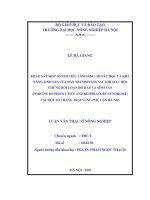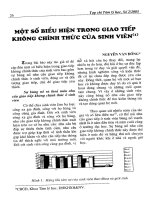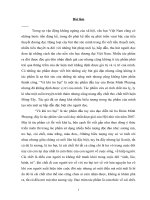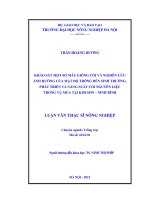Khảo sát một số biểu hiện lâm sàng, yếu tố dịch tễ của tầm cảm lưỡng cực
Bạn đang xem bản rút gọn của tài liệu. Xem và tải ngay bản đầy đủ của tài liệu tại đây (313.6 KB, 15 trang )
KHẢO SÁT MỘT SỐ BIỂU HIỆN LÂM SÀNG, YẾU TỐ DỊCH TỄ
CỦA TRẦM CẢM LƯỠNG CỰC
TÓM TẮT
Mở đầu: Trầm cảm lưỡng cực (TCLC) là một bệnh lý khá phổ biến. Bệnh dễ
chẩn đoán nhầm với trầm cảm đơn cực (TCĐC), dẫn đến việc điều trị không
hiệu quả.
Mục tiêu: Khảo sát một số đặc điểm về dịch tễ và lâm sàng của trầm cảm
lưỡng cực ở bệnh nhân giai đoạn trầm cảm nặng tại khoa khám bệnh viện Tâm
Thần thành phố Hồ Chí Minh.
Phương pháp: Thiết kế nghiên cứu: mô tả cắt ngang, Bối cảnh và thời gian:
khoa khám bệnh viện Tâm Thần TP.HCM từ 01/06/2007 – 31/05/2008. Bệnh
nhân: tất cả các bệnh nhân có giai đoạn trầm cảm chủ yếu theo tiêu chuẩn
DSM-IV-TR. Chẩn đoán bệnh nhân TCĐC nếu tiền sử chỉ có cơn trầm cảm.
Chẩn đoán bệnh nhân trầm cảm lưỡng cực TCLC nếu trong tiền sử có ít nhất
một cơn hưng cảm hoặc cơn hưng cảm nhẹ theo tiêu chuẩn DSM-IV-TR
Kết quả: Trong 84 bệnh nhân giai đoạn trầm cảm nặng có 38 bệnh nhân trầm
cảm lưỡng cực (45,2%), [9 bệnh nhân rối loạn lưỡng cực I (10,7%), 29 bệnh
nhân rối loạn lưỡng cực II (34,5%)], 46 bệnh nhân trầm cảm đơn cực
(54,8%).TCLC khởi phát sớm hơn TCĐC (23,92±6,04 tuổi so với 50,9±14
tuổi). Tỉ lệ nữ/nam là 2/1. Không có sự khác biệt đáng kể giữa các trình độ học
vấn, nghề nghiệp. Thời gian trung bình của giai đoạn trầm cảm trong TCLC
ngắn hơn so với TCĐC (4,1±1,5 tháng so với 4,1±1,5 tháng). Bệnh nhân TCLC
tái phát nhiều cơn trầm cảm hơn bệnh nhân TCĐC (2,45±1,6 cơn so với
0,3±0,6 cơn). Bệnh nhân trầm cảm với tiền căn gia đình có rối loạn lưỡng cực
hoặc trầm cảm khởi phát sau sanh thường là TCLC. Bệnh nhân TCLC thường
biểu hiện triệu chứng lâm sàng không điển hình như tăng cân, ngủ nhiều, hoang
tưởng bị tội, kích động. Tỉ lệ bệnh nhân TCLC có ý tưởng-hành vi tự sát và
triệu chứng loạn thần cao hơn TCĐC.
Kết luận: TCLC chiếm một tỷ lệ khá cao trong số bệnh nhân được chẩn đoán
giai đoạn trầm cảm nặng. Rối loạn này thường biểu hiện triệu chứng lâm sàng
không điển hình, vì vậy chúng ta cần chẩn đoán chính xác để có những phương
pháp điều trị thích hợp.
Từ khóa: trầm cảm lưỡng cực (TCLC), trầm cảm đơn cực (TCĐC), rối loạn
lưỡng cực I (RLLC I), rối loạn lưỡng cực II (RLLC I).
ABSTRACT
STUDYING SOME EPIDEMIOLOGICAL CHARACTERISTICS AND
CLINICAL FEATURES OF OUTPATIENTS WITH BIPOLAR
DEPRESSION
Ngo Tich Linh, Le Thi Kien Truc * Y Hoc TP. Ho Chi Minh * Vol. 14 -
Supplement of No 1-2010: 425-429
Background: Bipolar depression makes up a high percentage of mental health
diseases. It is easily to be misdiagnosed as unipolar depression, consequently,
the treatment procedure of the disorder is ineffective.
Objective: To study some epidemiological characteristics and clinical features
of outpatients with bipolar depression who have a current major depressive
episode at Mental Hospital’s Clinic in Ho Chi Minh City.
Method: Design: cross-sectional descriptive study. Setting and time: at Mental
Hospital’s Clinic in Ho Chi Minh City, between June 1st, 2007 and May 31st,
2008. Patients: all outpatients met DSM-IV-TR criteria for major depressive
episode. Patients were diagnosed with unipolar depression if they have had
neither a manic episode nor a hypomanic episode in their history. Patients were
diagnosed with bipolar I depression or bipolar II depression if they have had
one or more mania episodes or hypomania episodes in their history (based on
DSM-IV-TR criteria for bipolar I disorder and bipolar II disorder).
Results: Among 84 patients suffering a current major depressive episode, there
were 38 patients with bipolar depression (45.2%), including 9 patients with
bipolar I disorder (10.7%) and 29 patients with bipolar II disorder (34.5%) and
46 patients with unipolar depression (54.8%). The onset of bipolar depression
was earlier than that of unipolar depression (23.92±6.04 year-old vs. 50.9±14
year-old), the ratio of women to men was 2 to 1. There is no significant
difference in education levels, occupations. The mean length of depressive
episode of bipolar depression was shorter than that of unipolar depression
(4.1±1.5 months vs. 10.5±1.5 months). Patients with bipolar depression
experienced more recurrence of depressive episodes than patients with unipolar
depression (2.45±1.6 episodes vs. 0.3±0.6 episodes). Patients who had family
history with bipolar disorder or the ones who had a postpartum onset
depressive disorder were usually bipolar depressive ones. Patients with bipolar
depression usually presented atypical clinical symptoms such as overweight,
increased sleep, delusions of guilt, agitation. The rate of patients with bipolar
depression who had thought of death, suicide and psychotic symptoms was
higher than the rate of whom with unipolar depression.
Conclusions: There is a rather high rate of bipolar depression in patients who
are diagnosed with a major depressive episode. This disorder usually presents
atypical clinical symptoms. As a result of this, an exact diagnosis is needed to
have appropriate treatments.
Key words: Bipolar depression, unipolar depression, bipolar I disorder,
bipolar II disorder.
ĐẶT VẤN ĐỀ
TCLC là một bệnh lý khá phổ biến, tần suất bệnh khoảng 5,5% trong dân
số
(Error! Reference source not found.)(Error! Reference source not found.)
. Nhưng nhiều nghiên cứu
cho thấy một tỉ lệ lớn bệnh nhân rối loạn lưỡng cực bị chẩn đoán nhầm là rối
loạn trầm cảm chủ yếu
(Error! Reference source not found.)
. Việc điều trị của hai rối loạn
này khác nhau rõ rệt
(Error! Reference source not found.)
. Phát hiện sớm và điều trị sớm rối
loạn lưỡng cực là quan trọng, tránh nguy cơ tự sát, ly hôn, suy giảm khả năng
học tập và làm việc, sự ghét bỏ-xa lánh của gia đình và bạn bè, vấn đề rắc rối
với pháp luật
(5)
. Vì vậy khảo sát đặc điểm dịch tễ học, những nét đặc trưng lâm
sàng của TCLC góp phần mang lại những hiểu biết nhất định về rối loạn này
giúp chẩn đoán tốt hơn và chọn lựa phương pháp điều trị thích hợp.
ĐỐI TƯỢNG - PHƯƠNG PHÁP NGHIÊN CỨU
Thiết kế nghiên cứu: mô tả cắt ngang
Chọn mẫu: bệnh nhân trầm cảm nặng theo tiêu chuẩn DSM-IV-TR đến khám
tại khoa phòng khám bệnh viện Tâm Thần TP.HCM từ 01/06/2007 –
31/05/2008.
Thu thập thông tin dựa trên bảng câu hỏi soạn sẵn.
Chẩn đoán bệnh TCĐC nếu tiền sử chỉ có cơn trầm cảm.
Chẩn đoán TCLC nếu trong tiền sử có ít nhất một cơn hưng cảm hoặc cơn









